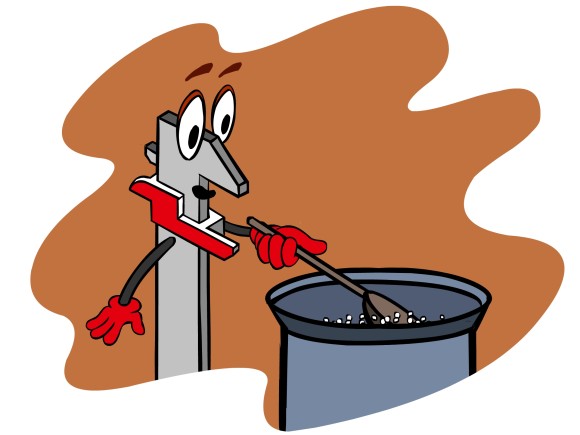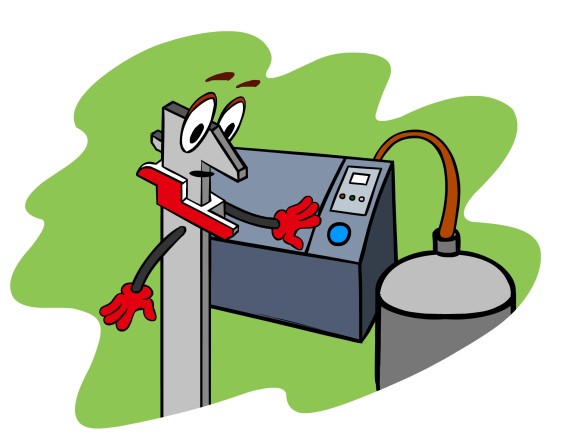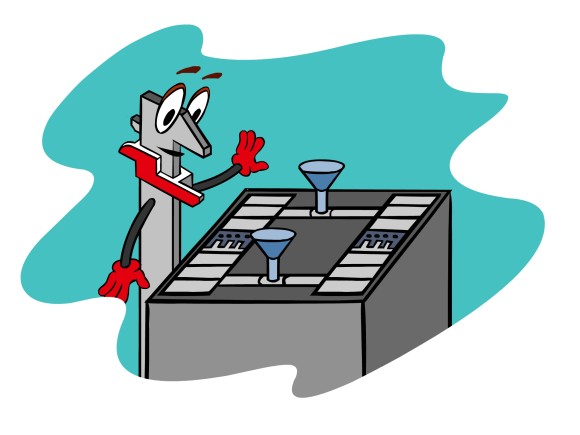Salt spray test – Mr. Caliper explaisn how it works
Mr. Caliper, what exactly is corrosion?
Definition according to DIN EN ISO 8044:2015-12:
Corrosion is the physical-chemical interaction between a metal and its environment that results in changes in the properties of the metal, and that may lead to significant impairment of the function of the metal, the environment or the technical system.
In simple terms:
Various interactions of the environment (e.g. rain or sunlight) damage the coating or the base metal thereby affecting the appearance or the mechanical properties. Red rust is the most common type of corrosion.
Why is it important?
The products are coated with various coatings to protect the components from corrosion for as long as possible or necessary. In addition to having a visual impact, these coatings also protect the base metal from external factors to maintain the functionality of the product for as long as possible or necessary.
Which corrosion tests can be performed in the laboratory of Würth Industri Norge?
The laboratory can perform neutral salt spray tests (NSS) according to DIN EN ISO 9227 for fasteners of various dimensions and coatings.
The test duration defined for the white and red rust cannot be compared with the actual environment or translated into a durability of the product:
The results of the test are considered as comparative values, in order to be able to compare the different coatings with each other, ensure the minimum requirements of the coating and evaluate the coating process.
Test sequence
Mr. Caliper ensures that the stage of the salt spray test is successful and follows the planned procedure. Thus, we receive an assured test result and the tour becomes an experience!

The requirements for the coating (thresholds for red and white rust) are checked, incoming goods are documented and the test position is defined in the suitability test. In this step, the product is visually checked for damages, impact points or a damaged coating. Then it is documented by taking photographs.
Since the samples are usually tested “as delivered”, a sample preparation is not necessary.


You need to follow some steps to perform the tests in the salt spray chamber accurately.
Salt water solution:
For the solution, demineralised water, which should not exceed a certain conductivity, and salt should be used. The salt should meet a high standard of purity. After the “ingredients” are mixed and dissolved, the pH-value should be set by using acids or alkalis. Before using the solution, the salinity and the pH-value should be checked again.
Sample:
During the neutral salt spray test, the samples should be arranged at a specific angle in the chamber. For this purpose, the universally applicable brackets are used, which meet this requirement. Moreover, the samples should not touch each other or be arranged on top of each other, as this could affect the test result.
Machine:
Various settings have to be adjusted in the salt spray chamber. Here it is important to set the temperature, duration and flow rate of the saline solution. The flow rate is crucial for further checks.

After making all the necessary preparations to perform a salt spray test according to DIN EN ISO 9227, the test can be started. The test accounts for 1000 hours and more depending on the coating type. The samples are checked for anomalies on a daily basis and, if found, are recorded during the test. Furthermore, the deposit accumulates in two measuring containers, which are in the chamber. The accumulated deposit is also checked for salinity, pH-value and quantity on a daily basis. This check is done to ensure that the chamber is functioning constantly and properly in a normative manner during the entire duration of the test.

All the important data regarding the test is noted down in the report.
This includes, as in case of all the reports of Würth Industrie Service, details of the corresponding samples, the tester, the last calibration and the requirements for the product.
The anomalies gathered during the test are described clearly in the test report and additionally documented by taking photos.
Complete overview of the tests
Go to the complete overview and select the next test to learn about further details from Mr. Caliper!
Go to complete overview
Go to the next test
Go to the next test of our test laboratory with Mr. Caliper and find out about the core hardness test!
Go to core hardness test
The Würth Industrie Service GmbH & Co. KG collects and processes the personal data provided in the form in order to process the requested request for you. Please note the mandatory fields in the forms. The legal basis for this processing, the absolutely necessary data, is Art. 6 para. 1 lit. b DSGVO, implementation of a pre-contractual measure. The processing of data voluntarily provided by you is carried out on the basis of Art. 6 para. 1 lit. f DSGVO. Thereafter, processing is permissible which is necessary to safeguard our legitimate interests. Our legitimate interest is to have contact with you, our customers, to improve our consulting quality and to be able to contact you more easily in case of possible queries. The data collected will only be stored by us for as long as is necessary to process your enquiry and to contact you. They are then deleted.
Supplementary data protection information, in particular regarding your rights to information, correction, deletion, restriction of processing, objection and complaint, can be found in our data protection declaration.
